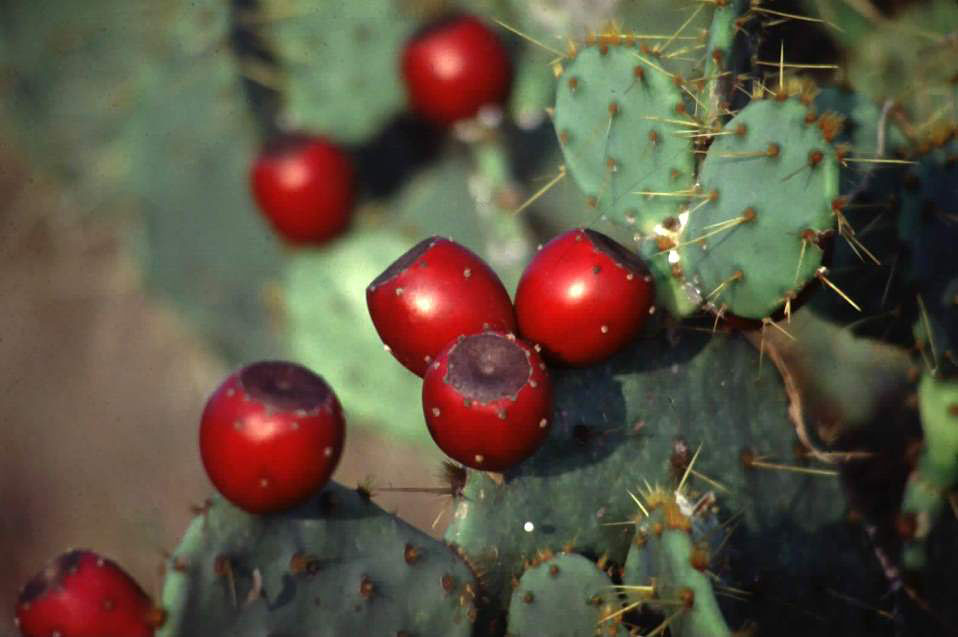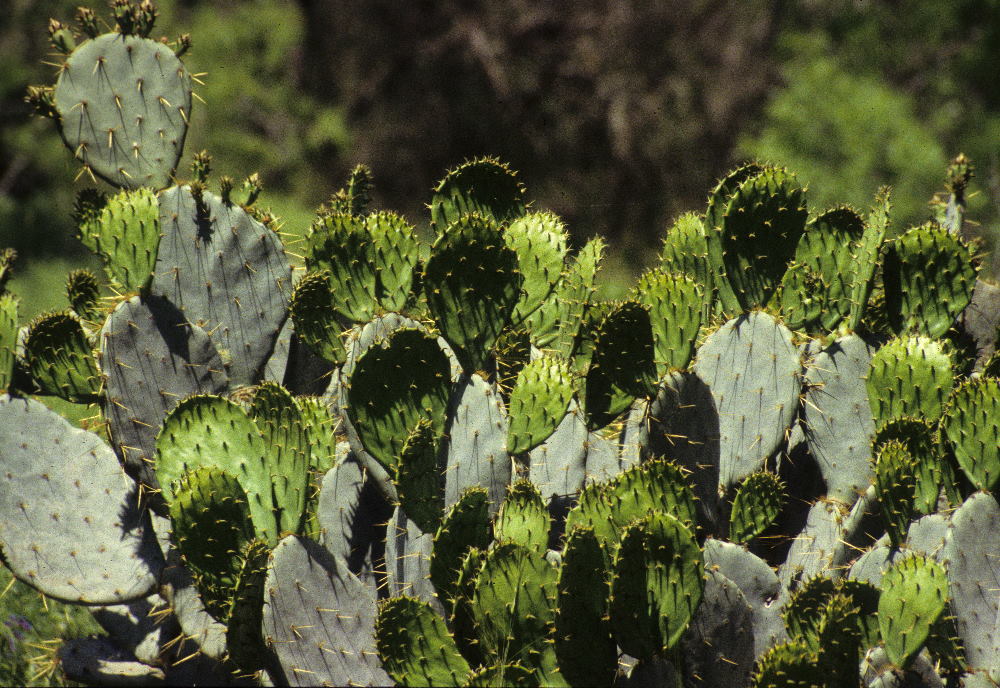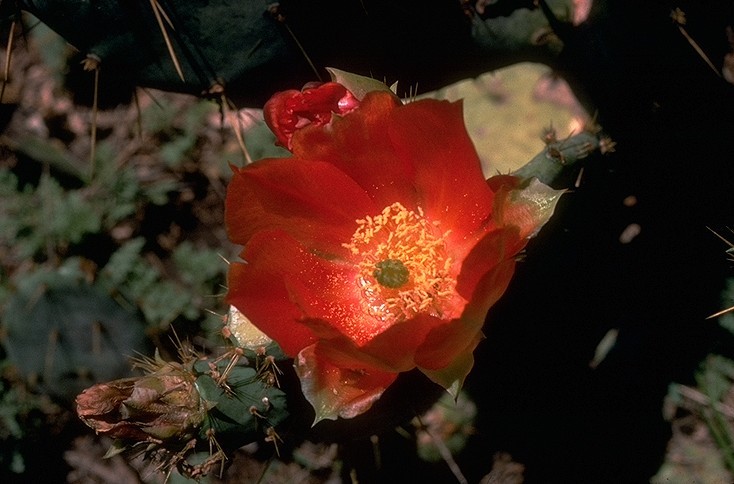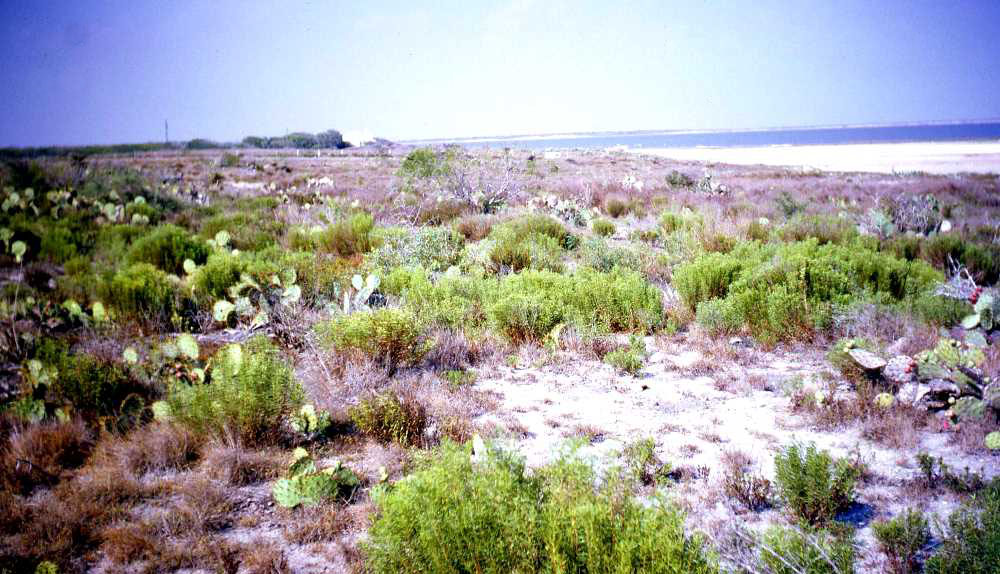Prickly Pear
Opuntia engelmanni Salm-Dyck ex Engelmann
Opuntia spp.
Cactaceae (Cactus Family)
Prickly pear is a large cactus with flattened, mostly spiny stems that produce deep red, juicy and sweet fruits. Early historic observations and archeological data indicate Native Americans relied on prickly pear for food, medicine, and as a source of needles, containers, and water. Although the largest stands are located inland, it is likely that coastal Indians utilized prickly pear as a food source, for the seeds have been recovered from at least one prehistoric site in the Coastal Bend.
Prickly pear gets its name from numerous sharp spines borne on the stems, and from the seasonal fruits known as pears or tunas. The long, sharp spines (the prickly part of the name) are actually modified leaves that harden as they age. Technically, the plant's “branches,” known as pads or nopales, are succulent, evergreen stem segments. The fruits, known as tunas, ripen in midsummer to a deep red color, and contain a sweet purple-red juice. The tunas are harvested by many animals as well as people.
Along the Texas coast, as in southern Texas, the most common species of prickly pear is Opuntia engelmannii, (Blum and Jones 1985; Johnston 1963; Judd 2002; McAlister and McAlister 1990; McMahan, et al. 1984). Prickly pear is more widespread and abundant from the Coastal Bend south, although it grows on Matagorda Island and Matagorda Peninsula and along the upper Texas coast in fewer numbers. The plant can multiply into dense, shrubby clumps covering large tracts of land. The broken off stem segments readily take root and create whole plants, which means that if a grazing animal or other force disturbs the plant, the scattered stem segments or pads simply take root where they drop, spreading the plant across an ever widening area (Dodd 1968).
It is also likely that coastal Native American groups accessed larger stands of prickly pear located a few miles inland. There are fairly dense concentrations on the King Ranch, and extremely large stands west of the Nueces River in Duval and Jim Wells Counties. Stands exist west of the Nueces River, between San Diego and Alice, and southward to the area around Falfurrias (Campbell and Campbell 1981). Another scholar locates the tuna gathering grounds northwest of Beeville and just south of the Nueces River near Freer (Krieger 2002).
At least along the middle to lower Texas coast, Native Americans could encounter large stands by walking a few miles inland in any direction. Johnston (1963) observed that the southern Texas savannahs, a mix of grassy prairies and thorn scrub, were shaped by a combination of fire and local soil types, and that large stands of prickly pear were also present in the clayey soils on the inner coastal plain. Suffice to say that throughout the South Texas Plains there were areas where prickly pear grew in high densities. During the tuna harvest these areas would have been a magnet for seasonal aggregations of native peoples.
Archeology. Very few large-scale excavations have been completed on the coast of Texas. Because preservation of organic archeological materials is poor in this region, those excavations that have been completed have not yielded much in the way of plant remains. However, a recent project on Oso Bay in Corpus Christi has yielded some material, including prickly pear seeds from a hearth feature located on low clay dunes overlooking the bay. The identification of plant materials from 41NU2 demonstrates that improved excavation and recovery methods will improve our understanding of plant use on the coast.
The other notable occurrence of prickly pear involved the excavation of a sampling of a historic site, most notably, a 17th century French ship, the Belle. La Salle's ship had been exploring the Texas coast for about one year before running aground in Matagorda Bay during the early months of 1686 (Dering 2004). Prickly pear seeds were recovered from the bilge of La Belle. The story is a fascinating portrait of men caught in circumstances far exceeding their survival abilities.
In the closing days of 1684 three French ships began the exploration of the unfamiliar Texas coastline. Shallow seas and bays, narrow passes bordered by shifting sandbars, and relentless onshore winds challenged the seamen. The low coastline was home to unfamiliar plants and animals, and the vast majority of the 200 or so people who were about to become stranded were not prepared for the hardships this land would bring to them.
The Frenchmen's inability to communicate with the Native Americans living along the coast quickly led to enmity between the two groups, isolating the settlers from a valuable source of local knowledge. Translated journals of the few men who survived their stay recount their failed attempt to settle the area and illustrate their profound ignorance of wilderness-living skills (Foster 1998; Weddle 2001). Yet in spite of the general inability, or lack of will, to adapt and survive, a few men in the group, most notably Henri Joutel, Robert Cavelier de La Salle, Jean-Baptiste Minet, and the Talon brothers demonstrated some aptitude for learning the land.
Although the bilge samples contained plants from the Old World, the Caribbean, and Texas, it is likely that Texas plants were brought on board both during the exploration and after the ship was stranded. The explorers continued to use the stranded ship for some time even after supplies were off-loaded to shore.
Prickly pear grows on Matagorda Island, on low terraces surrounding the bays, and is scattered throughout the region on low cuestas or other erosional breaks. It grew in sufficient quantity to be noted by the explorers. Joutel (Foster 1998:124) describes the plants as “. . . raquettes because they have a leaf of that same shape. They bear flowers around the leaves which sprout fruit that look almost like figs. But the leaves are full of quills, and even the fruit have them all around.”
The fruit proved tempting to some of the men in La Salle's crew. They were very hungry, primarily because the officers controlled the food supplies and kept much of them away from the crew. The men were tempted by the red prickly pear fruit and disobeyed the order to avoid them. As they had no idea how to prepare the fruit, they simply stuffed them into their mouths and started chewing.
La Salle maintained that a few men choked to death on the prickly pear fruit because they did not first remove the fine spines or glochids that grow on the surface (Weddle 2001:11). Joutel, referring to the tuna as a fig, provides a detailed description of the fruit and how improperly ingesting it killed one of his men.
One must strip the fruit before eating it because, although the quills are quite small and almost imperceptible, without fail they make one sick once they lodge in the throat and on the roof of the mouth. One of our soldiers even died from having eaten the fig greedily without wiping it. All these quills caused tremendous inflammation of the throat and eventually suffocated him. These fruits do not have much taste and come in all sizes, shapes, and colors (Foster 1998:124).
Prickly pear fruit tend to ripen slowly, changing colors from green to light red to dark purple, and can stay on the plant for long periods of time if grazing pressure is light. This may explain Joutel's observation about the variation in size, shape, and color. Although prickly pear is also native to the West Indies, the ignorance demonstrated by the explorers suggests that they did not encounter the plant until they reached the Texas coast.
Prickly pear pads (green fleshy stems) were edible, and even used as containers. Both the immature pads (nopalitos) and the mature pads (nopales) were consumed by the foragers of the past. Although the immature pad can be eaten raw, the mature pad most likely was baked first.
Food. Please heed the following warning. Although they share many positive benefits, there are critical differences between the domesticated prickly pear (Opuntia ficus-indica) and the wild species of prickly pear that most of the Native Americans consumed (Opuntia engelmannii and others). Even the immature pads and ripe fruit of wild prickly pear cactus can have very small spines that cause inflammation of the tongue and throat. These must be removed carefully. However, if you carefully remove the spines and prickly tufts, both the fruit and pads, especially the young pads (nopalitos) are edible. Although 85-90% water by weight, prickly pear fruit is rich in Vitamin C and is a good source of carbohydrates. The pads contain fewer carbohydrates but are rich in Vitamin A.
It is smarter to buy the spineless, cultivated variety at the grocery store. Nopalitos are available in the fresh fruits and vegetables section of most grocery stores, as are the tunas (fruit). The grocery store nopales and tunas are grown from a spineless prickly pear variety originally developed by the famous plant breeder Luther Burbank.
The most famous ethnohistoric account of prickly pear use is the great recorded by Cabeza de Vaca, the first European to cross Texas and write a first-hand report. In midsummer many different groups would converge on the area in southern Texas where prickly pear was ripening, and this was their favorite time of the year.
They would squeeze the juice out of the fruit and dry the pulp and skin (Covey 1983). He also describes how they “gathered many tuna leaves and roasted them in an oven, and we gave them so much fire that [the tuna leaves] were ready to eat” (Krieger 2002).
Ethnographic accounts of prickly pear that were recorded outside of Texas give us more ideas about the use of this plant. Tunas are harvested by knocking or twisting the fruits off the pads into a basket. The stiff hairs that cover the fruits need to be removed before they are consumed, and this can be accomplished by parching the fruit in hot coals or rubbing off the hairs using a rock. The fruits can be eaten raw, or they can be pounded in a mortar and pestle
Typical preparation of the fruit includes drying and pressing fruits in to a large flatcake, as done by the Yavapai. There are examples of the fruit being pit-baked, as is reported for the Cahuilla. The Cahuilla pick the fleshy young fruit of Opuntia basilaris in early summer and steam or bake it (Bean and Saubel 1972). Opuntia engelmannii fruit is very juicy and needs only to be pounded and sun-dried. Although there are no ethnographic references to pit-baking green or partially ripened Opuntia engelmannii, Phil Dering has pit-baked the green or partially fruit and found it to be palatable.
Medicine and other uses. Prickly pear pads also have very useful medicinal applications, and the dietary value of the immature pads, or nopalitos, may prove to be important in controlling or preventing Type 2 (adult onset) diabetes. Here are some of the historic and modern uses of nopales documented by oral history as well as some actual medical research. Although some of these uses might work for wilderness first aid in extreme situations, please don't try out these techniques at home without the guidance of a medical professional.
- Hot poultice of prickly pear pad skin applied to boils
- Split pads used as a hemostat to stop bleeding
- Infusion of pads used to treat urinary tract infections
- Mucilage (pulp) in raw nopalitos reduces rate of sugar absorption, hence they are effectively reduce symptoms of insulin shock
- Mature pads as poultice and antiseptic for wounds
- Mature pads to treat burns
- Tea made from pads for treating tuberculosis scar tissue
- Mucilage from mature pads kills bacteria in cultures, so it has antibiotic properties
- Hot poultice of prickly pear pad skin applied to boils
- Split pads used as a hemostat to stop bleeding
- Infusion of pads used to treat swollen prostate
The pads are high in calcium, both insoluble calcium oxalate and soluble mucilage. They have a hypoglycemic effect, significantly lowering cholesterol and preventing glycemia. Soluble fibers, including viscous mucilage, inhibit the absorption of simple carbohydrates. Pads also contain high levels of amylose, a starch that breaks down into simple sugars more slowly than amylopectin, the starch in bread and potatoes. Mature pads, however, contain calcium oxalate crystals that are insoluble and may cause health problems. According to Laredo herbalist Tony Ramirez, nopales are useful in “preventing diet-related cardiovascular disease and adult onset diabetes” as well as protecting the male prostate gland. (Fowler 2001).
References
Bean, L., and K. Saubel
1972 Temalpakh: Cahuilla Indian Knowledge and Usage of Plants. Malki Museum Press.
Blum, M. and J. R. Jones.
1985 Variation in vegetation density and foredune complexity at north Padre Island, Texas. Texas Journal of Science 37: 63-73
Covey, Cyclone, translator and editor
1983 Adventures in the Unknown Interior of America by Alvar Nunez Cabeza de Vaca. University of New Mexico Press. [reprint of 1961 edition published by Crowell-Collier Publishing].
Campbell, Thomas N., and T.J. Campbell
1981 Historic Indian Groups of the Choke Canyon Reservoir and Surrounding Area. Choke Canyon Series Volume 1. Center for Archeological Research. The University of Texas at San Antonio. San Antonio, Texas.
Collins, Michael B. and Thomas R. Hester
1968 A Wooden Mortar and Pestle From Val Verde County, Texas. Bulletin of the Texas Archeological Society 39:1-8.
Dering, J.P.
2004 Plant Remains from the Belle. Report submitted to the Texas Historical Commission.
2008 Plant Remains from 41NU2. Report submitted to the Center for Archaeological Research. The University of Texas at San Antonio.
Dodd, J.D.
1968 Mechanical Control of pricklypear and other wood species on the Rio Grande Plains. Journal of Range Management 21:366-370.
Fowler, Gene
2001 Rattler Oil, Mesquite Beans and Prickly Pear: Medicine from Nature's Pharmacy. Texas Co-Op Power, September.
Foster, William C, ed.
1998 La Salle Expedition to Texas: The Journal of Henri Joutel, 1684-1687. Texas State Historical Association, Austin.
Gutierrez, Miguel A.
1998 Medicinal Use of the Latin Food Staple Nopales: The Prickly Pear Cactus. Nutrition Bytes 4(2) Article 3. http://repositories.cdlib.org/uclabiolchem/
nutritionbytes/vol4/iss2/art3,
accessed August 14, 2006.
Johnston, M. C.
1963 Past and Present Grasslands of Texas and Mexico. Ecology 44(3):456- 466.
Krieger, Alex D.
2002 We Came Naked and Barefoot: The Journey of Cabeza de Vaca across North America. University of Texas Press. Austin.
Judd, F.W.
2002 Tamaulipan Biotic Province. In The Laguna Madre of Texas and Tamaulipas. Gulf Coast Studies Series, 2, ed. by J.W. Tunnel and F.W. Judd, pp. 38-58. Texas A&M University Corpus Christi. Corpus Christi, Texas.
McAlister, W.H. and M.K. McAlister
1990 Matagorda Island, A Naturalist’s Guide. University of Texas Press. Austin.
Weddle, Robert
2001 The Wreck of La Belle, The Ruin of La Salle. Texas A&M University Press. College Station, Texas.




